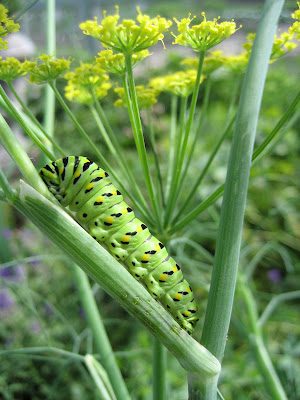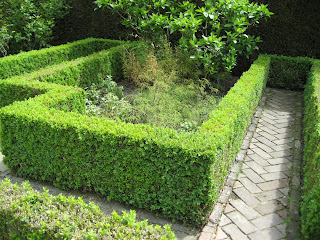
Designed in 1930 by poet/author Vida Sackville-West and her husband, Sir Harold Nicolson, this
progressive couple supported each other in the creation of their home and landscape. In addition to rebuilding the ruined rooms of their castle, Vida guided the building of outdoor rooms that still surround the main residence and the famous tower that served as her study. It is truly the gardens of Sissinghurst that survive the impassioned lives of Vida and Sir Harold, and puts on display the kind of bond that only happens between gardeners.
It was about 10 a.m. at Great Dixter. I was working in the Sunk Garden deadheading tulips when Aaron whisked me away to visit Sissinghurst with Sarah, Fergus' assistant. It really is so convenient that Vida and Harry chose a ruin just down the street from the Llyods. Aaron navigated the crazy country roads to Sissinghurst like the pro he is. There were busses, full parking lots, and all sorts of proper folk gravitating toward this hexagonal tower. Certain death? Wacky Kool-aid? No, thanks. Maybe some other time.
Aaron, who by nature and nurture is not easily impressed, gave me the speediest tour of any garden I have ever been on, well, save for MS on Mount Desert Island . . . but I digress. Basically, he's seen the gardens 174 times and wanted to show us the features of the garden that were most important to see. There was no lolling about or pining over plants. As a result, I have a succinct understanding of the garden as a whole.
The Reader's Digest version of Sissinghurst is this: the Lime Walk, the Fall garden, the Hazel coppice, the Azalea and Wall garden, the White Garden, the hedging, the hedging, the hedging, the tower courtyard, and the biggest, fattest, Rosmarinus officinalis growing happily in the ground at the foot of Vida's tower. And! Ceanothus!, And! . . . Now I understand why Aaron sped through -- this could take all day, and we might miss tea.
The Lime Walk is located to the far right of the gardens, so while it is a destination when it looks fantastic, it is not a focused featured throughout the season.
The Lime walk had seen it. It is primarily a spring garden profuse with bulbs. No wonder why they hid it behind a Taxus hedge to hide the wreckage. Smart. My initial reaction was, "Why isn't it cleaned up, planted, etc, etc." But, Hello! This garden is huge, and I know all about setting garden priorities when time and labor is at a premium. I had to ask, what is the deal with Limes? They aren't hardy, and it certainly was not the tree I was questioning. The answer was Tilia platyphyllos. Its flowers have a delicious fragrance similar to -- we're all smart people here -- lime blossoms! Even though my timing was off, I could just imagine walking through this lovely allée viewing whatever fabulous geophyitic display through the open windows of the tree trunks, woven together with the thick sweetness of lime blossoms.

The Fall room looked great in mid-spring.
The wallflowers boasted about themselves in voices of reds, oranges, and yellows. Such saturated colors were a welcome respite to the Easter-egg gag reflex I usually experience with the spring color palette. I'm out to change all that.
(Pssst! So you see that chunk of chartreuse on the upper right? Oh, my god. The most amazing, luscious stand of
Euphobia characias I have NEVER seen before. I wanted to stand there all day, screw the tea. Sadly, not hardy in my zone 5b-6, but who says? Just so the world knows, the
Euphorbiaceae is my FAVORITE plant family.)
The Hazel coppice was a very pretty part of the garden. Not enough to be pretty, it also had a function.
Coppicing is an ancient practice that was very widespread especially in that part of England. Each year, branches were cut down for firewood, fencing, etc. As a response, the tree/shrub sends up long shoots from latent buds. Talk about sustainability: each year a new and reliable source of fuel and raw materials was available. En route to the garden, we actually drove right through old coppiced woods with the clubby wounds as proof of the repeated cuts.
Peering through the coppice, a statuary is sentinel. What struck me as sheer brilliance are the shadowed and glowing ferns all framed under the canopy of Corylus. Sir Harry designed this part, and how stellar the result. Garden design 101 here: repetition propels the eye forward. Now, 101 does not mean elementary; it means fundamental.
The azaleas were just on fire! Why does spring have to be a washed out introduction to a lively new season? No. After the bleak ick of winter neutrals, I want some eye candy!
Huge specimens of orange and yellow azaleas proved that this flamboyant couple were nothing if not inspired.
The wall was interesting; little hunks of mortar had been removed to accommodate plants that seemed to clutch you into them. Think Labyrinth circa David Bowie (aaahh).
Sissinghurst is famous for its White Garden. While I was not impressed with the early season show of white-flowered and silver-leaved perennials, I did fall in love with the structural elements of the layout. The meticulously trained and trimmed boxwood followed a slim serpentine pattern. The yew hedge behind it created planting areas in the bulges of the design. Who am I, but if I had a garden styled similarly, I would keep one type of plant growing in each enclosure. Cold? Maybe. Bold? Definitely. Thats the beauty of seeing other gardens and taking them one step further for yourself. You can't argue with inspiration.
Don't try to tell me you can't see the humor in this. Well, I suppose the incredible geometry should stand out more.
The strict hedging gave the garden a kind of precision. It felt official, stately, and well, proper. The lines were just so clean that it was the perfect visual element to balance the romanticism felt throughout the garden.

In this garden, I imagine the dark corridors commence at dull heartache past openings of hope, to a destination at the warmth and light of a new love.
In her own words, her garden is "profusion within the confines of uttermost linear severity". Well, Vida was a poet.










 The Fall room looked great in mid-spring.
The Fall room looked great in mid-spring.














